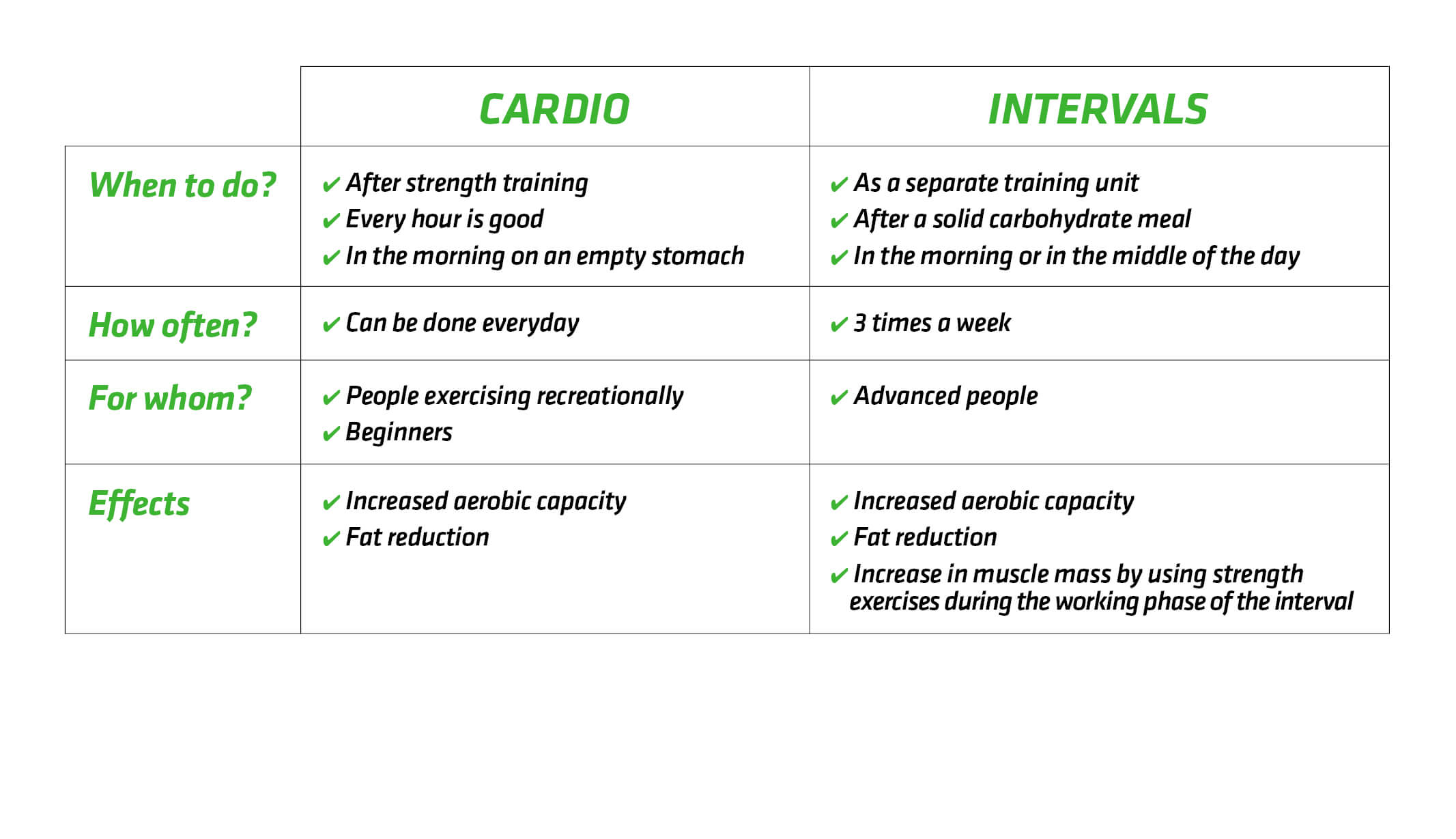This age-old dilemma gives many gymgoers sleepless nights. Each personal trainer has his own opinion on this subject and everyone recommends something different to the exercisers. Everyone, of course, has a set of scientific facts for arguing their theses. What if I collect and provide you with reliable information and the pros and cons of each of these forms of training?
To understand the process of fat burning, one should become acquainted with several basic principles of biochemistry of the human body and with the types of training: aerobic and anaerobic.

Aerobic training
The traditional aerobic training (cardio) must be characterized by the appropriate range of heart rate and it should be, depending on the source, from 55 to 65% HR max (heart rate max). Only in this compartment of the heart rate there are oxygen conversions and fatty acids are used to obtain energy. We must remember that if we only come to the gym for a cardio session, it should last at least 45 minutes. The reason for this is the fact that for the initial duration of training, our body burns muscle glycogen, because it is always easily available and the glucose from which it is built is the basic source of energy for all processes occurring in the system. After about 15 minutes, the body switches to fat burning. So, we only have 30 minutes of training left, and this is the least needed to burn a significant number of calories, which will lead us to reduce weight.

The basic and often encountered mistake is the incorrect order of exercising strength training and aerobic training (the most popular combination that leads to a positive body composition recompilation if it is properly planned). Performing aerobic training before strength training causes the burning of muscle glycogen in the first place, and then when we go to strength training the body burns its own muscles because they are anaerobic exercises and energy is needed for anaerobic processes that take place quickly, i.e. using glucose. Yes, there is no mistake in the previous sentence.
The human body can cope with the lack of glucose through the process of gluconeogenesis. It consists in the transformation of non-sugar precursors, e.g. amino acids (proteins) into glucose molecules, from which the previously mentioned glycogen is built. So, I hope you understand how important the order in your training is. Remember that nothing is accidental at the gym. If you already know the process of gluconeogenesis, please avoid it and first do strength training (use glycogen for energy production), then go for low to medium intensity cardio (55-65% HR max) and burn body fat. Then the whole process will go as it should and in a much shorter time you will get closer to your dream figure.
Aerobic training
Aerobic training will be recommended for people who, in addition to cardio, exercise strength training with weights a lot. This combination allows you not to strain the central nervous system and avoid overtraining. It is also recommended for people who train in the evening, because traditional cardio training does not stimulate the body as it does interval training and thanks to that you will not have any sleep problems. If we are strongly excited, there may be problems with falling asleep and sleep will be low-quality.
It is also worth noting that conducting a morning cardio session on an empty stomach allows for the most effective burning of body fat, because after a restful night in our body is little glycogen accumulated, and not eating breakfast does not replenish it, so we can immediately burn body fat.
However, I would like to emphasize that the training session should not be carried out completely on an empty stomach - it is worth taking BCAA branched chain amino acids beforehand, which will help to avoid the catabolism of our muscle mass.
Anaerobic training
Anaerobic training is characterized by high, bordering with maximum intensity (75% HR max and more). Usually this training is also shorter, because the very hard work done during it does not allow us to maintain high performance for a longer time. A perfect example of such training is Tabata, which lasts 4 minutes and is called the fastest training in the world. It consists in performing intervals according to the 20-second work schedule and 10-second rest pattern.
Tabata, although it seems innocent, is recommended only to advanced people, because in order to bring the expected effect, it must be performed in 100% of our abilities, which is why the beginners are not usually capable.
During the intervals, glycogen is used as fuel, so before training you should eat carbohydrate-rich meals, which will later translate into our increased efficiency. However, after an intense session of intervals, the body burns more body fat up to a dozen or so hours than in the resting state. This is caused by the "metabolic boost" resulting from a very intense effort. Our body is stimulated, the circulation is improved, and the muscles are solidly strained which results in increased caloric demand for the regeneration of the body. If, of course, we want to burn body fat and if we control the calories consumed, we will systematically lose weight because the body will switch to collecting energy from stored fat stores without reacting to the increased appetite after interval training.
Intervals are recommended for people with limited time for training. It is inadvisable to perform them in the late evening, while those made in the morning excellently stimulate circulation, make us think better and more energetic during the day.
Remember that even light cardio training may be inadvisable to people with serious heart disease, hypertension, asthma, etc. Before starting the training, it is worth consulting your doctor and finding out if you can train safely.

Comparison of the features and benefits of aerobic (cardio) and anaerobic training (intervals)





